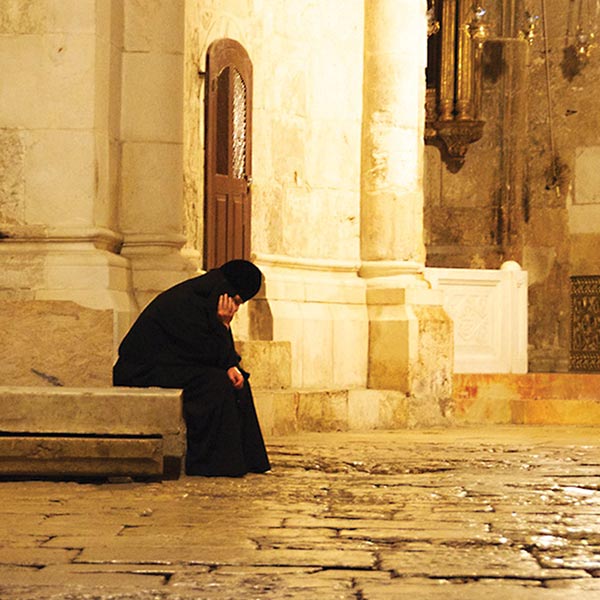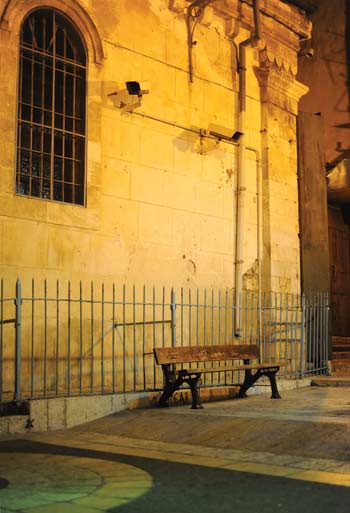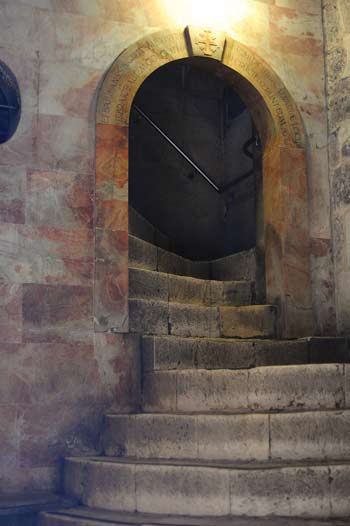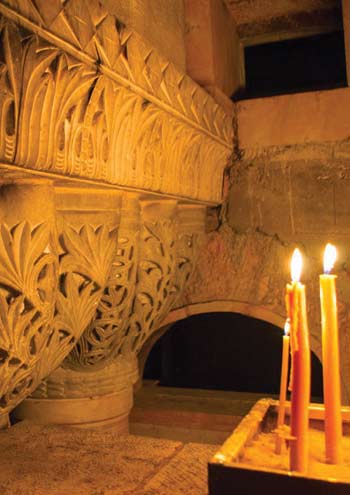Subtotal: $
Checkout-

A Book to End All Walls
-

Edna Lewis
-

The Dead Breed Beauty
-

Table Fellowship
-

Covering the Cover: The Welcome Table
-

Restoring a Creek
-

What I Stand For Is What I Stand On
-

Feasting in Kurdistan
-

The Birthday Party at the End of the World
-

From Farm to Feast
-

Readers Respond: Issue 20
-

Family and Friends: Issue 20
-

Streams in the Desert
-

The Boy and the Bull
-

This Is My Body
-

The Greatest Thing Since Sliced Bread
-

The Ground of Hospitality
-

Beating the Big Dry
-

Cows and Elephants
-

At the Welcome Table I
-

At the Welcome Table II
-

Love Is Work
-

How Shall We Farm?
-

Why Yemen Starves
-

Digging Deeper: Issue 20
-

Cloth and Cup
-

Level
-

Editors’ Picks Issue 20

The Necessity of Reverence
Conversion is a grace, but we must cultivate a pilgrim’s eye for beauty.
By Sister Dominic Mary Heath, OP
November 10, 2023
This article originally appeared in the Spring 2019 issue of Plough Quarterly: The Welcome Table.
“Holy sepulchre, Batman!” It’s a saying my family coined on a trip to the Holy Land when I was a child. The idea of pilgrimage was still foreign to my family of American evangelicals, and I remember my dad turning to me as we entered the tomb of Christ in Jerusalem, a site at the heart of Christian devotion to the Incarnation: “Holy Sepulchre… Batman!” he said, and I echoed it back to him.
This saying, which has since become something of a family joke, captures the typical irreverence of tourists. Too often, that’s what tourists do: tame uncommon beauty with everyday irreverence. For every one soul flooded with grace in a sacred space like the ancient Church of the Holy Sepulchre, there are floods of tourists moved simply by curiosity and a very natural desire to see something famous. Sudden exposure to beauty just doesn’t work miracles for a lot of people, even those who should “know better.”
Discussions on beauty in evangelization tend to overlook just this point: conversion is a grace, but reverence is cultivated. Reverence is not a heightened emotional state provoked by a bring-me-to-my-knees aesthetic experience. It’s an attitude that involves a certain way of seeing the world, a discernment of the excellence in things and particularly the excellence of God, which gives me the capacity first to recognize, then to receive, the beautiful. Reverence can tell me what I’m looking for when I behold something beautiful. And when it tells me I’m looking for Christ, I become a pilgrim with purpose, not a tourist without aim.
The good news is that even if you can’t get to a famous cathedral in Jerusalem, Cologne, Santiago, or Westminster, you can cultivate reverence.
What Is Reverence?
Reverence is the attitude of submission we owe to God as the source of our being. It is the posture proper to us as human persons who should recognize our finitude: I did not make myself and I do not hold myself in being. Reverence can be called a posture in both senses of the word: it involves not only the subjection of our minds, but also the humbling of our bodies. The first leads to the second, like charity in the heart leads to charity in deeds. In fact, the posture of reverence is formed in us by a whole host of virtues with charity at their head. Reverence thrives on charity because charity is a love of God, self, and neighbor for God’s own sake that informs all the Christian virtues, animating and perfecting them like the soul informs, or animates, the body.

A pilgrim rests at the Church of the Holy Sepulchre, Jerusalem. Photo reproduced by permission of Scott Gunn.
Charity forms reverence in us, first, by teaching us the fear of the Lord. When our fear of God is a slave-like fear of punishment, our reverence is real but imperfect. Reverence reaches its perfection when our fear matures into a childlike dread of separation from a beloved Father. As Saint Augustine says, “It is one thing to be afraid he may come, another to be afraid he may leave you.” Brought to perfection by love, reverence becomes the sign of the Holy Spirit in us crying “Abba! Father!” (Gal. 4:6).
God, of course, is not just any father; he is the first principle of creation and the eternal wisdom governing all things. We revere him not because of his goodness (this is the object of our love), but because of his excellence. Reverence takes excellence as its object because it is a humbled response to what excels us. This gives reverence a special relation to another set of virtues – the virtues of justice.
Most of us know that justice renders to each what he or she is due. What may be surprising, however, is the name justice takes when it renders due reverence to God: it’s called religion. Religion is the moral virtue, belonging to justice, that pays God reverence by interior acts of devotion and prayer and by exterior acts of adoration and sacrifice. These acts are virtuous, not when they are sudden and coerced, but when they are sweet and habitual to us. A virtue in this sense is always something we’re good at. Religion makes us good at revering God because it gives us the ready will to do so. A person with the habit of religion has the benefit of a soul rightly ordered to God and creation.
Conversion is a grace, but reverence is cultivated.
Right order is the principle that distinguishes Christian reverence from all merely natural instincts about God as a “higher power.” It’s no longer possible for us to reverence God generically when we know that the eternal Word, Second Person of the Trinity, has forever united himself to human nature (the ongoing mystery we call the Incarnation). All I just said about reverence as a humbled posture expressing charity, religion, and holy fear applies equally to our reverence for Christ in his humanity – his body, blood, and soul – and divinity. The Incarnation makes one huge exception to the rule that we must worship the Creator of beauty but not the beauty of creation: Christ is simply both.
Christ, in his humanity, brings the excellence of God near to us. We owe him reverence because he is God from eternity, but also because his sacred humanity is the source of our life of grace in time and space. It is for our sakes, according to Saint Cyril of Alexandria, that the Spirit descended upon Christ at his baptism: “If we reason correctly, and use also the testimony of Scripture, we can see that Christ did not receive the Spirit for himself, but rather for us in him; for it is through Christ that all gifts come down to us.”
Reverence, rightly ordered, is a humbled submission to the one who humbled himself to share in our humanity, who continues to share his divine life with us. An attitude like this will overflow into our lives: at the Holy Sepulchre it could mean all the difference between Mary Magdalene’s encounter with the one who has risen and my own childhood encounter with the one who flies over Gotham.
Imitating Reverence
No matter how old we are, the first way to learn reverence is in the childlike mode of imitation. A second story from my early trip to the Holy Land illustrates this for me vividly. This time we were in Emmaus, the village mentioned at the very end of Luke’s Gospel. In that account, two Christian disciples meet a stranger on their journey from Jerusalem but only recognize him as Christ “in the breaking of the bread” (Luke 24:35).
Emmaus is a place of epiphany, and on the hot, bright day when I walked into a monastery built on the site, I experienced that for myself. There were no tourists, but the church wasn’t empty. Looking down from an upper loft, we could see nuns prostrate below us in total silence. I had never seen a nun before, but I was immediately overawed by what they were doing. What were they doing? I really didn’t know, but as I watched them I fell as silent and still as they were.
Twenty years went by without remark on this memory, which is why I was even more delighted when my dad brought it up recently. “You remember that too?” I asked in surprise. The Wailing Wall, Holy Sepulchre, Jordan River, and Gethsemane – nothing made as vivid an impression on us as the nuns in Emmaus. And now I understand what they were doing that day: keeping silent adoration before the Blessed Sacrament where, like the disciples before them, they recognized and reverenced Christ “in the breaking of the bread.”

A bench in the Old City of Jerusalem Photograph by Guillaume Paumier
These examples illustrate a point: children intuit meaning in things they can’t yet fully understand. With the right teachers, they pick up more than good manners – they pick up good ideas. The nuns in Emmaus taught my dad and me something that all the buildings and sites we had visited had not. Their reverence was not a mental calculation; it was a full-bodied response to the truth they knew about who God is and how he dwells among us. I didn’t have to understand all that to learn it.
We don’t have to be young in years to learn reverence this way; we just have to turn and become as receptive as little children. For most of us, that will mean letting go of a certain cynicism, suspicion, and even dullness toward spiritual realities that we’ve learned from our highly developed consumer instincts: What am I being sold? How am I being manipulated? What can I get out of this?
It’s frightening to realize how deliberately irreverent our secular culture is. Alongside vast ignorance and inexperience there is something truly demonic at work here. Satan, after all, is the one who refused to serve. Irreverence is intrinsically disordered and, despite its seductive hold on our culture, basically ugly. If we cultivate it by choice, it chokes out the movements of charity, religion, and holy fear in us.
Understanding Reverence
Many of us, unfortunately, won’t find good role models of reverence close by. But another way to learn reverence, which is open to all of us, is to grow in understanding.
I once met a man in his sixties who complained to me about the simplistic way his third-grade teacher had explained heaven to him. She told the class that they should imagine having good things in heaven just like they have good things now. For example, if they lived in a blue house, they would have a blue house in heaven. This analogy, similar to the one C. S. Lewis uses in The Last Battle, didn’t sit well with him as a child: his family lived in an apartment!
“Now, isn’t that a silly way to explain heaven?” he asked me.
“Yes,” I agreed. “But you’re not a child anymore. What have you done since third grade to understand heaven better?”
His is a common mentality. Many people grow up enough to criticize their first, childish ideas about faith, but don’t follow through to more mature ideas about God, creation, and the human person. Left in a state of arrested development, reverence can’t ripen.
To learn reverence, we have to become as receptive as little children.
Understanding allows us to experience reverence in its mature mode. It is the necessary completion of childlike imitation, no matter how young or old we are when we begin to comprehend divine truths. Understanding is something we can cultivate ourselves, firstly by studying the truths of nature and revelation, and secondly by removing misconceptions that are obstacles to reverence in our lives. If I imagine that God is a crotchety old man in the sky, for example, and don’t know that he is spirit infinitely perfect and blessed in himself, who has created me to share in his goodness, I won’t be able to assume an authentic posture of subjection to him, one of gratitude and supplication.
The point is that when I walk into a place of sacred beauty, the ideas I bring with me really matter. Irreverence grows out of ugly ideas I have about creation, the human person, and God’s saving providence. These misconceptions make it difficult for me to recognize beauty no matter how much of it I see around me. Becoming aware of my own misconceptions can open me to the experience of beauty in its three traditional properties – proportion, integrity, and clarity – and serve as a remedy for irreverence itself.
Reverence in a Flat World
One misconception that keeps us from experiencing the beauty of creation is radical egalitarianism. The culture around us endorses total equality in the worst sense of the word – we prefer to live in a flat world. The idea that I should submit to the excellence of another, God or not, is somewhat offensive. What we can’t abide about the idea of reverence is its reliance on hierarchy, and we don’t realize that an allergy to hierarchy is a reaction against a property of beauty itself, called proportion.
Proportion, as an aesthetic value, signifies the pleasure my mind takes in order and unity. We experience proportion in small ways every day: when we walk into a clean space instead of a cluttered one, or listen to a favorite song instead of the sound of traffic. On a much larger scale, however, the beauty of proportion is written into the universe itself.

Stairway in the Church of the Holy Sepulchre Photograph by Guillaume Paumier
That’s because the universe has a form. Not a shape, mind you, but a principle that constitutes its proper perfection. It not only is something: it’s also becoming something. And though we can’t yet see entirely what God has in mind for it, the form of creation is already visible in the order and diversity of its parts. It shows us what it is by showing us the beauty of its proportions.
This instinct for the hierarchy in the universe is deeply Christian. Augustine, for example, paints the scene this way: “Where does God’s creation begin? With the angels. And where does God’s creation leave off? With the mortal things of earth. The created order has an upward limit, beyond which is God; the created order has a downward limit, beyond which is nothing.” Each being is placed. It is ordered. It is desired by God as one possible expression of his own infinite beauty among all others. But the point is that it belongs and it depends.
Depending on another is of the essence of hierarchy, and it’s at the heart of created beauty. In fact, if you want a good example of dependent beauty, look at the human person in the attitude of reverence. We’ve already said that the first act of reverence is to submit the mind to God. But how?
The answer has to do with our place in the hierarchy of creation, and with the fact that we have both material needs and spiritual desires. It has to do with our capacity to grow in knowledge, love, and holiness. The answer is that reverence prays as Christ taught us.
Prayer is proper to someone in need, someone who depends. By prayer we accede to our place in creation and open ourselves to receive what God wants to give us as his children, made in his image and remade by baptism (Gen. 1:27; Rom. 6:3–4; Eph. 1:5). The hierarchy here is all in our favor, because lesser things are perfected by higher ones. What we gain by reverent prayer is nothing less than our own perfection. Listen to Saint Thomas Aquinas: “By the very fact that we revere and honor God, our mind is subjected to him; wherein its perfection consists, since a thing is perfected by being subject to its superior, for instance the body is perfected by being quickened by the soul, and the air by being enlightened by the sun.”
In other words, just like life and light flow into the world from higher causes, so purity and firmness of mind flow into my soul from God when I revere him. This effect in me is called sanctity, and there is nothing, absolutely nothing, more attractive in creation. It is the beauty of being proportioned to divine things by grace and of sharing in Christ’s own prayer to the Father who is “greater than all” (John 10:29). But in a flat world of low horizons, we miss this beauty.
Reverence and Bodies
Disregard for the body is a second common idea, one that keeps us from experiencing the beauty of the human person. Most of us are very comfortable with an easygoing attitude that says, “No worries, what I do with my body is spiritually irrelevant.” The idea that bodies have responsibilities is unfamiliar, and the fact that reverence makes demands on our bodies seems rude. Reverence, religion, God: these are matters of the mind and soul.

Church of the Holy Sepulchre Photograph by Mari. Used by permission.
Meanwhile, however, we’re clearly missing something. And that’s not a bad definition of ugly. Beauty is characterized by integrity. Integrity as an aesthetic value refers to the pleasure our minds take in seeing completeness and wholeness in things. It is the beauty of a thing that has all its parts, neither too many nor too few. It pleases me because through it I glimpse something of God – the fullness of being – himself. If I want to see the beauty of the world and my place in it (proportion), I can’t overlook the fact that I am a soul and a body (integrity). It’s precisely the integrity of the human person that explains why we owe God acts of embodied reverence.
We need our bodies in order to receive knowledge of the world around us. We derive knowledge from our five senses, all day long, every day of our lives. What’s fascinating, however, is that we receive knowledge of God in the same way. God has chosen to reveal himself to us according to the embodied mode of the human nature he has given us – incrementally, over time, using sensible words and deeds that are often mediated through other people.
The bodily mediation of Christian revelation is a basic premise of the Incarnation: the Word became flesh to reveal the face of the Father whom no one has seen (John 1:18). What’s more, this mediation gives us a new perspective on the reverence we owe Christ in his humanity; it explains how what we pay him in justice returns to us in sweetness. Aquinas puts it this way:
Matters concerning the Godhead are, in themselves, the strongest incentive to love and consequently to devotion, because God is supremely lovable. Yet such is the weakness of the human mind that it needs a guiding hand, not only to the knowledge, but also to the love of Divine things by means of certain sensible objects known to us. Chief among these is the humanity of Christ.
Christ’s humanity is a divinely foreseen aid, a “guiding hand,” as Aquinas says; our hearts and minds are weak and cannot pierce the heavenly realms on their own. This is why reverence for Christ’s humanity – the kind of devotion motivating centuries of pilgrims to the Holy Sepulchre – is not an awkward compromise with superstition or an unfortunate falling away from pure, reasonable religion. Instead, it is an aid intrinsic to God’s ordinatio, or saving order: “God,” writes Saint Teresa of Avila, “desires that if we are going to please Him and receive His great favors, we must do so through the most sacred humanity of Christ, in whom He takes His delight.”
That God continues to work within this bodily mode is a basic premise of Christian anthropology for which we should be grateful. It not only means we can hear God in Christ. It also means we can speak back.
Our bodies speak reverence to God in the same way they have been spoken to: incrementally, over time, using sensible words and deeds often mediated through other people. For example, when we humble our bodies in God’s presence by bowing, kneeling, or even just folding our hands, we are using our bodies to speak reverence. When we deny our bodies by fasting, almsgiving, and other forms of Christian sacrifice, we are using them to speak reverence. When we gather our bodies at the times and places consecrated for God with the people of God, we are using them to speak reverence. And when we put our bodies at the service of others out of love for God and neighbor, we are using them to speak reverence.
At the same time, we are also shaping our lives into an integral whole that is nothing less than beautiful. But in a world where bodies have no responsibilities, we miss it.
Reverence and Providence
A third mindset does possibly more to mar our experience of beauty than the others because it is a misunderstanding about God himself. I’m referring to the habit of fatalism we’ve picked up from an unsavory friendship with materialism. When things – and their meaning – are reduced to matter and the laws of physics alone, what I see is what I get, and what I can’t see can’t mean much.
Fatalism like this blinds us to the actions of God in the world, and it makes the meaning of our own lives incomprehensible. Our heads may be full of the latest news, but our minds can’t discern the patterns of providence in these events. Meanwhile, the idea that we should revere a loving God who lets unloving things happen in the material world is hard to swallow. We doubt the beauty of divine providence because we don’t see it in all its clarity.
Clarity is the third property of beauty – its illuminative quality – that manifests the inherent radiance of all beautiful things. As an aesthetic value, clarity represents the pleasure our minds take in finding light and intelligibility in the world. Clarity is at work, for example, when we see a stained glass window lit up and understand the story the window tells.
Clarity outstrips both proportion and integrity in the delight it causes, in much the same way that love outpaces faith and hope: It first recapitulates and then surpasses them. But clarity also excels in mystery. As beauty goes, it can be very unclear indeed, especially if I’m used to sights that are cheap and flashy. Real clarity is neither of those things. As Jacques Maritain explains, “To define the beautiful by the radiance of the form is in reality to define it by the radiance of a mystery. It is a… misconception to reduce clarity in itself to clarity for us.”
The gap between what is clear in and of itself and what is clear for us is where the great mysteries of providence play out. It’s also where our attitude of reverence must find its perfection in the supernatural virtue of faith if it is to survive at all. Reverence perfected by faith shows us the inner light of God’s providence in everything that exists. With Saint Catherine of Siena, faith can say, “Hate sin and hold all else in reverence.”
Real faith is not blindness; it is a supernatural way of seeing.
It’s a common mistake to think that faith means closing our eyes and gritting our teeth against hard truths. Real faith is not blindness; it is a supernatural way of seeing that begins with the habit of believing God. Faith has God himself as its object, and it participates in God’s own vision of the world. It enjoys a clarity that surpasses our natural powers.
Take, for example, the beauty of the cross of Christ. Materially, we can point to a brutal and humiliating form of execution that is very dark, indeed. With the eyes of faith, however, we can see the cross differently. We see the material form of an uncreated love, infinity in flesh, which is the light and salvation of the soul. We see a mystery of divine love, “a plan for the fullness of time, to gather up all things in [Christ],” a mystery which is the light and salvation of the world (Eph. 1:10). We see a mystery of human love, gratitude and surrender to the Father, which is the light and salvation of all the suffering in our lives. And seeing all this, we can exclaim with the Psalmist, “but there is forgiveness with you, so that you may be revered” (Ps. 130:4).
By faith, we behold already what heaven will show us in absolute clarity: that the mystery of the cross has been the singular beauty of our lives. But in a world darkened to divine providence, we miss it.
God Is Near Us
Reverence opens our eyes to beauty in the order of creation, in the wholeness of human persons, and in the mystery of divine providence – beauty that is inaccessible to irreverent eyes. As an attitude that accompanies Christian life, reverence is not optional but necessary.
Do Christians also need beautiful buildings, liturgies, art, and literature in order to convert the world? Absolutely. Even more importantly perhaps, we need them in order to convert ourselves. But there’s an important sense in which each of us must cultivate a pilgrim’s eye for beauty in the places in which we already live and worship and in the daily crosses we already carry. That means recognizing God’s presence with us, in Christ, and submitting to him gladly through our practice of charity, religion, and holy fear. Once we begin to do that, our aesthetic experiences will show us more and more clearly that God is near us.
As a cloistered nun who no longer kneels in the great cathedrals, I can tell you that this kind of conversion by beauty is still possible, here in my own sacred space, with all its monastic simplicity.
Already a subscriber? Sign in
Try 3 months of unlimited access. Start your FREE TRIAL today. Cancel anytime.







































Ann Dayton
What a wonderful article! I would so like to have a printed version of it. Would you by any chance have a copy of the Spring 2019 issue for sale? If so, could you let me know how much it would cost to send it to me. Thanks. I have just taken out a subscription to the Print version of Plough = should have done so long ago!
Janice S
This beautifully written piece has expressed with great clarity the vague discontent I have been feeling about the world at large for a long time. Sister Dominic Mary has grasped the source of the persistent malaise that afflicts society and given us glimpse of the mountain to which we Christians should continue to aspire. Thank you from a Connecticut neighbor and fellow pilgrim.